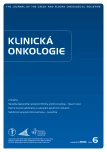Consequences of Hypoacidity Induced by Proton Pump Inhibitors – a Practical Approach
Authors:
J. Rychlíčková 1,2
Authors‘ workplace:
Ústavní lékárna, Masarykův onkologický ústav, Brno
1; Farmakologický ústav, LF MU Brno
2
Published in:
Klin Onkol 2018; 31(6): 409-413
Category:
Review
doi:
https://doi.org/10.14735/amko2018409
Overview
Background:
Proton pump inhibitors (PPIs) are often a part of drug regimens for many patients, including cancer patients. These drugs are very effective suppressors of gastric acid secretion; a significant increase in the gastric pH is seen with chronic use. This affects absorption of drugs, vitamins, and minerals.
Purpose:
PPIs are associated with many adverse drug reactions; nevertheless, these adverse effects are often neglected in clinical practice. The main aim of this article is to emphasize some of the adverse effects and theoretical mechanisms underlying these adverse reactions, the expected length of therapy before their clinical manifestation, and potential ways of dealing with these adverse reactions. We will focus on hypergastrinemia and rebound hyperacidity, which occur in patients on long-term therapy with high dose PPIs. Next, we will focus on osteoporosis and hypomagnesemia, adverse effects for which the assumed mechanism is decreased absorption of particular ions from the gastrointestinal tract. Furthermore, clinically significant pharmacokinetic drug interactions at the level of absorption will be analyzed. Tyrosine kinase inhibitors (TKIs) are drugs with limited solubility; this solubility is pH-dependent. Some recommendations seek to ensure optimal absorption with minimal inter-day variability. Tables summarizing the optimal relationship between food and TKIs, and (sometimes) the optimal regimen of concomitant PPIs, are included.
Key words:
proton pump inhibitors – drug-related side effects and adverse reactions – drug interactions – tyrosine kinase inhibitors – hypochlorhydria
The author declares she has no potential conflicts of interest concerning drugs, products, or services used in the study.
The Editorial Board declares that the manuscript met the ICMJE recommendation for biomedical papers.
Submitted: 24. 8. 2018
Accepted: 17. 10. 2018
Sources
1. Shin JM, Sachs G. Pharmacology of proton pump inhibitors. Curr Gastroenterol Rep 2008; 10(6): 528– 534.
2. Roche VF. The chemically elegant proton pump inhibitors. Am J Pharm Educ 2006; 70(5): 101.
3. Fellenius E, Berglindh T, Sachs G et al. Substituted benzimidazoles inhibit gastric acid secretion by blocking (H+ + K+)ATPase. Nature 1981; 290(5802): 159– 161.
4. Jianu CS, Fossmark R, Viset T et al. Gastric carcinoids after long-term use of a proton pump inhibitor. Aliment Pharmacol Ther 2012; 36(7): 644– 649. doi: 10.1111/ apt.12012.
5. Dacha S, Razvi M, Massaad J et al. Hypergastrinemia. Gastroenterol Rep (Oxf) 2015; 3(3): 201– 208. doi: 10.1093/ gastro/ gov004.
6. Graham DY, Genta RM. Long-term proton pump inhibitor use and gastrointestinal cancer. Curr Gastroenterol Rep 2008; 10(6): 543– 547.
7. Niklasson A, Lindström L, Simrén M et al. Dyspeptic symptom development after discontinuation of a proton pump inhibitor: a double-blind placebo-controlled trial. Am J Gastroenterol 2010; 105(7): 1531– 1537. doi: 10.1038/ ajg.2010.81.
8. Reimer C, Søndergaard B, Hilsted L et al. Proton-pump inhibitor therapy induces acid-related symptoms in healthy volunteers after withdrawal of therapy. Gastroenterology 2009; 137(1): 80– 87. doi: 10.1053/ j.gastro.2009.03.058.
9. Pandolfino J. Discontinuation of proton pump inhibitor therapy and the role of esophagel testing. Gastroenterol Hepatol (N Y) 2013; 9(11): 747– 764.
10. MacKenzie C, Nabila AS. Clinical indications for proton pump inhibitors and tapering information when indicated. [online]. Available from: https:/ / ahpnetwork.com/ wp-content/ uploads/ 2016/ 12/ Clinician-PPI-Flyer.Ahmed_.10.16.pdf.
11. Costa-Rodrigues J, Reis S, Teixeira S et al. Dose-dependent inhibitory effects of proton pump inhibitors on human osteoclastic and osteoblastic cell activity. FEBS J 2013; 280(20): 5052– 5064. doi: 10.1111/ febs.12478.
12. Ito T, Jensen RT. Association of long-term proton pump inhibitor therapy with bone fractures and effects on absorption of calcium, vitamin B12, iron, and magnesium. Curr Gastroenterol Rep 2010; 12(6): 448– 457. doi: 10.1007/ s11894-010-0141-0.
13. Targownik LE, Lix LM, Metge CJ et al. Use of proton pump inhibitors and risk of osteoporosis-related fractures. CMAJ 2008; 179(4): 319– 326. doi: 10.1503/ cmaj.071330.
14. Lamy O, Burckhardt P. Calcium revisited: part II calcium supplements and their effects. Bonekey Rep 2014; 3 : 579. doi: 10.1038/ bonekey.2014.74.
15. Reinwald S, Weaver CM, Kester JJ. The health benefits of calcium citrate malate: a review of the supporting science. Adv Food Nutr Res 2008; 54 : 219– 346. doi: 10.1016/ S1043-4526(07)00006-X.
16. Florentin M, Elisaf MS. Proton pump inhibitor-induced hypomagnesemia: a new challenge. World J Nephrol 2012; 1(6): 151– 154. doi: 10.5527/ wjn.v1.i6.151.
17. Shabajee N, Lamb EJ, Sturgess I et al. Omeprazole and refractory hypomagnesaemia. BMJ 2008; 337: a425. doi: 10.1136/ bmj.39505.738981.BE.
18. Epstein M, McGrath S, Law F. Proton-pump inhibitors and hypomagnesemic hypoparathyroidism. N Engl J Med 2006; 355(17): 1834– 1836. doi: 10.1056/ NEJMc066308.
19. Kuipers MT, Thang HD, Arntzenius AB. Hypomagnesaemia due to use of proton pump inhibitors – a review. Neth J Med 2009; 67(5): 169– 172.
20. El-Kattan A, Varma M. Oral absorption, intestinal metabolism and human oral bioavailability. In: Paxton J (ed). Topics on drug metabolism. Rijeka: InTech Europe 2012. [online]. Available from: https:/ / www.intechopen.com/ books/ topics-on-drug-metabolism/ oral-absorption-intestinal-metabolism-and-human-oral-bioavailability-.
21. Amidon GL, Lennernäs H, Shah VP et al. A theoretical basis for a biopharmaceutic drug classification: the correlation of in vitro drug product dissolution and in vivo bioavailability. Pharm Res 1995; 12(3): 413– 420.
22. van Leeuwen RW, van Gelder T, Mathijssen RH et al. Drug-drug interactions with tyrosine-kinase inhibitors: a clinical perspective. Lancet Oncol 2014; 15(8): e315– e326. doi: 10.1016/ S1470-2045(13)70579-5.
23. van Leeuwen RW, Peric R, Hussaarts KG et al. Influence of the acidic beverage cola on the absorption of erlotinib in patients with non-small-cell lung cancer. J Clin Oncol 2016; 34(12): 1309– 1314. doi: 10.1200/ JCO.2015.65.2560.
Labels
Paediatric clinical oncology Surgery Clinical oncologyArticle was published in
Clinical Oncology

2018 Issue 6
Most read in this issue
- Undifferentiated Carcinoma of the Pancreas – a Case Report
- Effect and Toxicity of Radiation Therapy in Selected Palliative Indications
- Consequences of Hypoacidity Induced by Proton Pump Inhibitors – a Practical Approach
- Diagnostic Challenges and Extraordinary Treatment Response in Rare Malignant PEComa Tumor of the Kidney
